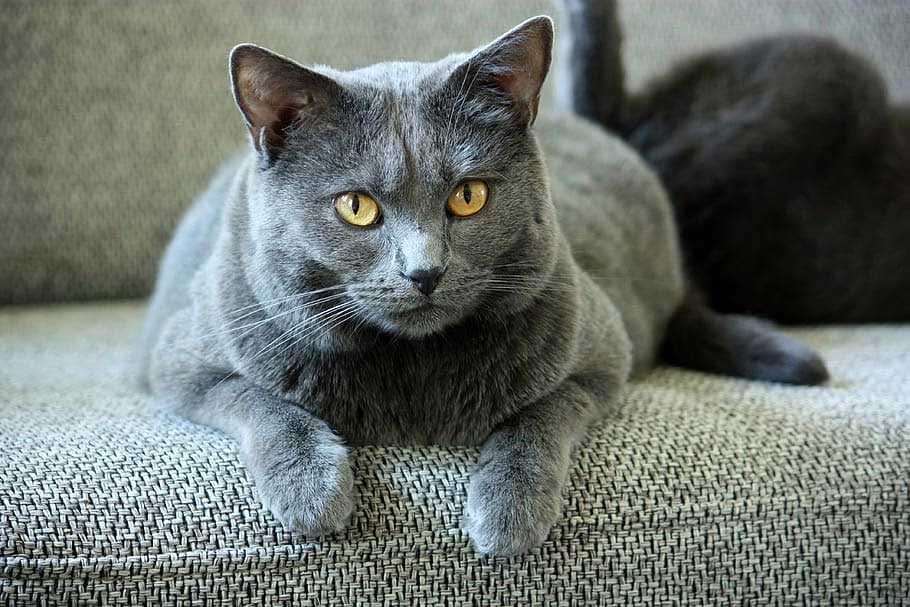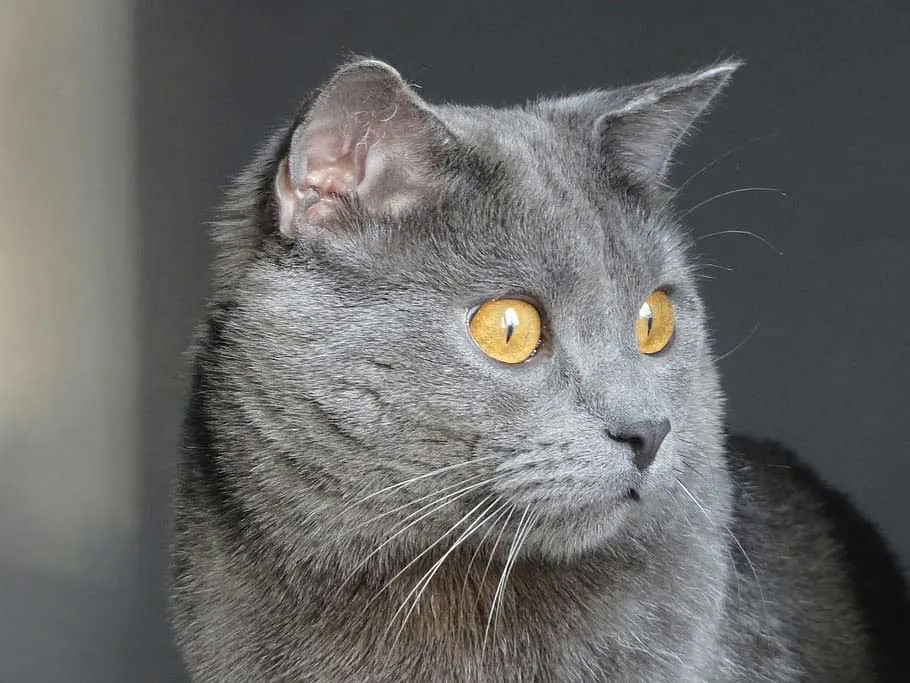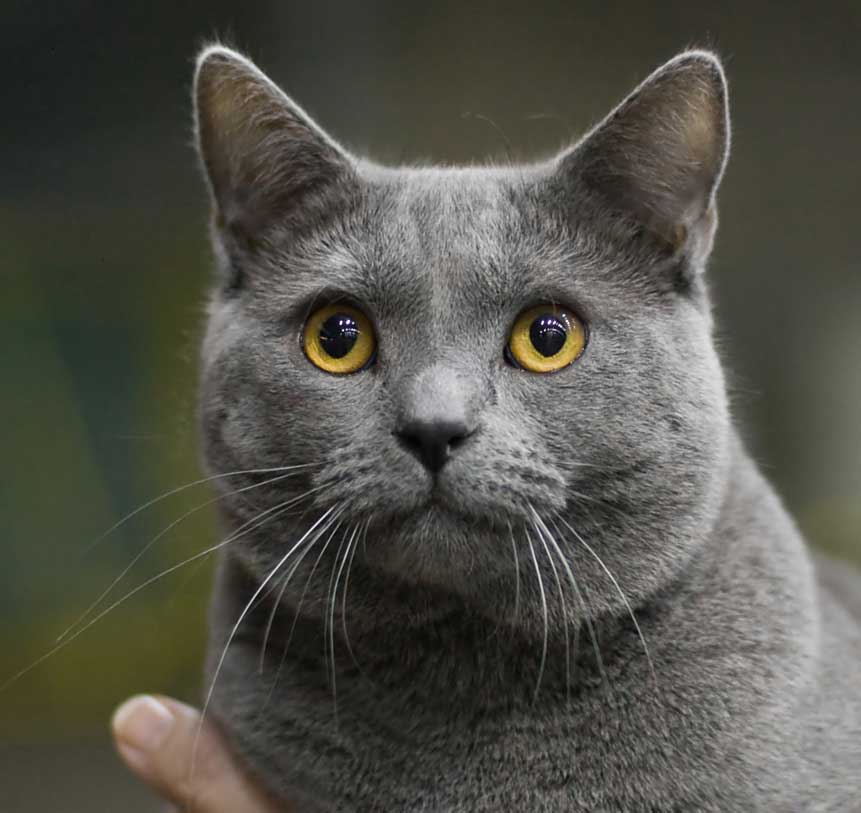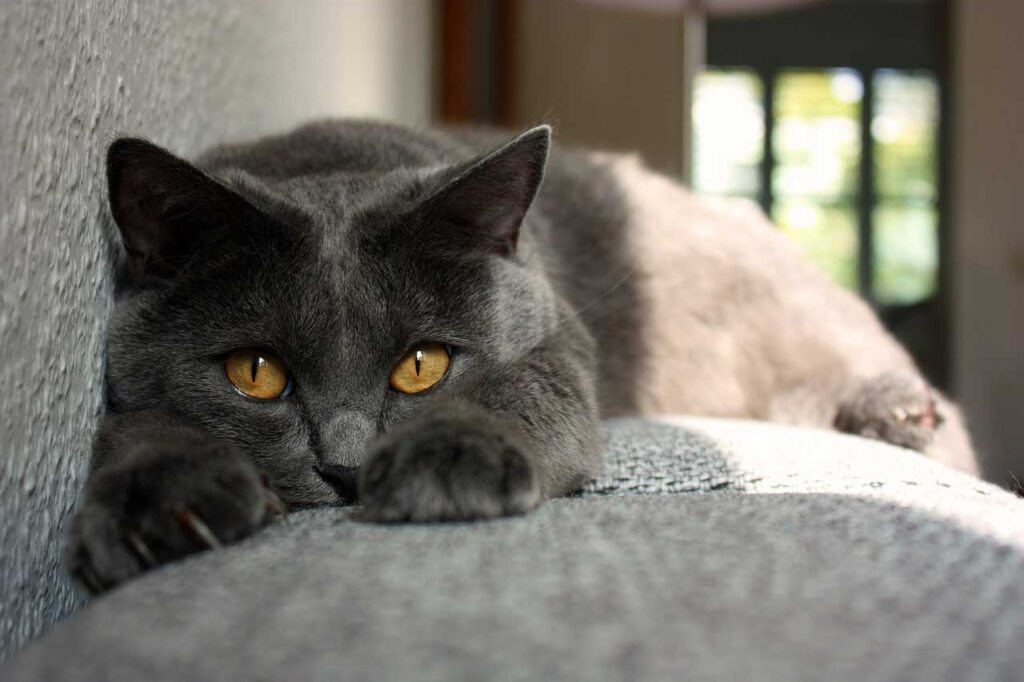Content |
|---|
Characteristics "Chartreux cat (Carthusian)"
Coexistence is important that you have with your new friend. Before considering the acquisition of a cat of the breed "Chartreux cat (Carthusian)" you know certain factors. You must take into account their character, their need for exercise, their interaction with other pets, their care and if you have small children, their level of tolerance towards them.
Joy3.0 out of 5 stars (based on 1 review)
|
Activity level3.0 out of 5 stars (based on 1 review)
|
Friendliness to other pets4.0 out of 5 stars (based on 1 review)
|
|---|---|---|
Friendliness to children4.0 out of 5 stars (based on 1 review)
|
Grooming requirements2.0 out of 5 stars (based on 1 review)
|
Vocality1.0 out of 5 stars (based on 1 review)
|
Need for attention3.0 out of 5 stars (based on 1 review)
|
Affection towards its owners4.0 out of 5 stars (based on 1 review)
|
Docility4.0 out of 5 stars (based on 1 review)
|
Intelligence4.0 out of 5 stars (based on 1 review)
|
Independence3.0 out of 5 stars (based on 1 review)
|
Hardiness4.0 out of 5 stars (based on 1 review)
|
History
The Chartreux cat, also called Carthusian Cat, it is an ancient cat breed: exists for several centuries (at least the XVIII), but its history is quite difficult to trace. In fact, only recently has genetic research been able to prove its Persian origin.
But, the vagueness of its history has allowed the existence of various accounts, before genetics has been able to clarify the true context of its appearance. The most popular is that it was created and raised in the Middle Ages by the monks of the Grande Chartreuse monastery, located north of Grenoble, in southeastern France. It is said that in his spare time, between prayers and the making of a famous green liquor, the monks were engaged in developing a calm breed of cat with a low-pitched meow, so as not to disturb during meditation sessions and moments of recollection. But, this beautiful story is really just a legend, since no written record of the monastery mentions the presence of any cat in its bosom. Another version is that the Carthusian cat was brought from the Near East by knights returning from the crusades between the 11th and 13th centuries..
Whatever the true story of its appearance, its presence in Europe was first documented in the 18th century. In the Dictionnaire universel du commerce, de l’histoire naturelle et des arts et métiers, written by the Frenchman Jacques Savary des Brûlons and published in 1723, we find the first reference to the name Chartreux in reference to the blue-robed cats. The author especially insists on his beautiful skin, which at that time was highly coveted for clothing.
It is also mentioned in the Systema naturae, written by Carl von Linné and published in 1735. This Swedish naturalist, who initiated the scientific classification of species, dio al Chartreux el nombre latino de Felis catus coeruleus. Georges-louis leclerc, Earl of Buffon, Nor did he stop including it in his monumental Natural History, published in 1749 and the fruit of several decades of work. In fact, one of the volumes lists the four breeds of cats that were common in various European countries at the time: the domestic cat, Angora, the spanish cat and the Chartreux.
But, some speculate that this cat - or at least one of its ancestors- was mentioned long before, in 1558, by the poet Joachim du Bellay. The latter owned a gray feline named Belaud, whom he described in his poem Epitaphe d’un chat like an excellent rat catcher. But, This description is too vague to suggest with certainty that it was a Carthusian cat. The fact that du Bellay specifies that it is “white underneath like an ermine” suggests even the opposite.
According to the book Le chat des Chartreux published in 1980 and written by Jean Simonnet, a breed enthusiast, the Chartreux is originally from the Middle East, and an animal identified as the Syrian Cat by the Italian naturalist Ulisse Aldrovandi (1522-1605) is probably one of your ancestors. The book even includes an illustration - based on Aldrovandi's research- of this stocky blue Syrian cat with copper and almond eyes. The drawing also shows a mouse curled up at his feet., symbolizing the cat's strong hunting instinct. It was for this particular reason that the Chartreux cat became popular and that his descendant became a popular companion.
The Chartreux it was probably brought to Europe by merchant ships from the Near East, more specifically from Persia (the current Iran), and quickly established itself as a French feline breed.
Its survival in Europe is proof of its great strength. In the 18th century (or even long before), lived mainly on the street and was used in stables, shops or houses for your hunting skills. But, her beautiful skin was used in the textile industry, so it was hunted for many years and had to learn to adapt.
Until the beginning of the 20th century, groups of stray cats with typical features of Chartreux continued to roam the streets of Paris and other parts of France, for example some Breton islands and the Massif Central. It was not until after World War I that lovers of the country's feline species decided to preserve the breed.. A great deal of work was done to gather as many individuals as possible with similar characteristics, and in the process a standard was developed.
You can't talk about the origins of the Chartreux not to mention sisters Christine and Suzanne Léger who, in 1920, discovered a group of blue shorthair cats in the town of Palais, in Belle-Île-en-Mer, off the coast of Brittany. This group, then wild, lived near the local hospital, -casually directed- by a religious order. The townspeople called them “the hospital cats”. Captivated by the beauty of these felines, the two sisters also began to work on the development of the breed, which was first shown at a cat show in Paris in 1931.
The breed quickly became very popular with the public, but the Second World War was about to decimate it. After the war, none of these cats were found in the wild, but there were still some domesticated representatives. They were crossed with the British Shorthair cat blue, the Russian Blue Cat and the Persian cat, in order to maintain bloodlines without the risk of inbreeding problems.
These crosses came very close to Chartreux cat and to the British Shorthair cat, that ended up being very similar. The Fédération Internationale Féline (FIFé), that in 1949 had recognized the Chartreux as a breed in its own right, came to merge the two standards in 1970, considering that the two cats were now one. Many enthusiasts of the Chartreux they expressed their discontent, especialmente a tal Jean Simonnet, who set out to restore the race to its former characteristics. In fact, the Chartreux has a shagier coat texture than the British Shorthair cat. It is also less massive, taller and has longer ears and tails. Simonnet founded a breed club in 1977, the Club of Chartreux cat, which still exists today and continues to work for the preservation of the breed. Thanks to these works, the cat regained its original appearance and continues today to correspond to the descriptions established at the beginning of its history. In 1977, FIFé decided to separate the two races again and the Chartreux had its own standard. Today, the organization prohibits crosses between both races; a Chartreux cat can only be crossed with a Chartreux, and the same goes for the British Shorthair cat.
The Chartreux entered the United States in 1970 by Helen Gamon de La Jolla, who imported the first representative from France to California and then started a breeding program. Still today, many of the lines present in North America are the result of his work.
The International Cat Association (TICA) recognized the Chartreux in 1979, and the Cat Hobbyists Association (CFA) did the same in 1987.
The Chartreux cat still a relatively unknown breed in North America, occupying the position 35 of 42 in the ranking of the most popular cat breeds in the United States, according to the number of annual registrations in the CFA. There has even been a certain decrease in interest, passing the post 25 to the 30 at the beginning of 2010.
Not much better in Canada, with little more than 50 cumulative births registered with the Canadian Cat Association (CCA) between 2016 and 2018.
The Chartreux cat, on the other hand, is much more present in what is considered its country of origin, that is to say, France. With an average of just over 2.000 births per year registered in the Livre Officiel des Origines Félines (LOOF), is even among the 10 favorite feline breeds of the French, representing something more than 4% of the population of purebred cats in the country.
But, even in europe, its popularity does not seem to have really crossed the borders of France. In Switzerland, bordering country with France and partly francophone, only a few are registered 60 births per year in the Fédération Féline Helvétique (FFH). This figure is in decline, since there were more than 100 since the beginning of the decade of 2000 until mid 2010.
The situation is not much better in Britain, with less than 50 records per year in the Governing Council of the Cat Fancy (GCCF). But, This can be explained by the fact that the body has only recognized race since 2017.

Physical characteristics
In any case, the cat's coat color is the same: blue, uniform, no stains and preferably shiny. All shades of blue are accepted, and slight silver reflections are appreciated. In kittens, slight tabby tones can be seen, but these should disappear as they approach adulthood.
Last, It should be noted that the Chartreux grows slowly, and only reaches full physical maturity among 4 and 5 years of age. This is especially true of the male., whose growth is slower than that of the female.
This breed is also characterized by a sexual dimorphism very marked, since the male is usually much heavier and taller than the female.
Size and weight

Character and skills
The Chartreux cat could be compared to a mime: quiet but very communicative.
Before they were used as hunters, are now employed as an excellent family company, although they continue to show their predatory abilities to protect the house and garden from rodents (and from vermin in general) whenever the opportunity presents itself. Its popularity as a pet is not free, as this loyal and very loving friend quickly finds a place in the home. They are known to live alongside their owners and have a sometimes close relationship with them, following them around the house and being aware of everything that happens.
When they get home, never fails to greet them with his enigmatic smile and soft purr. It´s, in effect, a purring cat of the first order, who knows very well how to express his satisfaction and well-being by this means. This well-being can also be communicated: this is the miracle of purr therapy.
Apart from this propensity to purr a lot, the Chartreux cat not at all a noisy companion. It's not the kind of animal that meows all the time, for example to order food. But, often opens his mouth and pretends to make noises, but no sound comes out.
The Chartreux much appreciates the attention, especially if it comes in the form of stroking and scratching under the chin or between the ears. But, as with food, they are not usually the kind that ask for it, content with what is given to them. It is important to get used to observing and paying attention to it, since he is not one of those who express his discontent, your discomfort or even your suffering, for example when you are the victim of a health problem.
In general, has a uniform personality (neither exuberant nor too shy) and is much more adaptable than most of his peers. These characteristics make it the favorite of truckers looking for animal company on long trips..
They can easily stay home alone while their owner is at work, but they are even happier if they have a playmate to entertain them during those times. They are quite sociable and generally get along well with other cats.. Living with a dog is also possible, as long as he is not too aggressive with him. On the other hand, in view of his strong hunting instinct, trying to get it to share the same roof as a rodent or bird is not recommended, since the experience could be a failure.
Inside to the family, this feline tends to form a very strong bond with a particular person. But, remain friendly and cuddly with everyone else. As for the children, get along with them, as long as they are calm with him. So, it is necessary to teach them to behave with this cat, who especially does not like being carried around the house by unruly children. Having said that, even though i'm irritated, is never aggressive: if you feel embarrassed by someone's behavior, it just walks away.
If a stranger comes to the house, does not rush to greet him, like some cats do, not the kind of event to blow it up. Has a little trouble accepting the newcomer, but then he goes on quietly with his life, without looking too annoying.
Your character traits, in particular their calm and collected character and the fact that they love to spend time on their owner's lap, make them an ideal cat breed for seniors. But, do not ignore the need for activity of this playful animal with a highly developed sense of humor. They love to playfully interact with their humans and are especially fond of feathery toys that swirl in the air., which stimulates one of your strongest instincts: the hunter. In the same line, chasing balls is also one of his favorite activities. He is a great climber and is known to be capable of impressive stunts during play sessions..
In addition to physical exercise, likes to stimulate himself with games that test his great intelligence. It is this intelligence that makes him quickly recognize your name and teach you tricks.. But, do not deprive yourself of learning by yourself, as when it comes to inserting drawers or opening doors… Wide awake and always alert, he is fascinated by everything that happens inside and outside the house. Loves looking out the window or watching TV shows, for example.
Don't be fooled by its quiet and discreet character. They are cunning and clever with their paws, But they will soon flee from their owners when curiosity wins them over and the opportunity presents itself.. In fact, has an amazing ability to find ways to get out of the house, including opening doors or shutters.
It follows from the above that you need an environment with many stimuli and that access to the outdoors is highly recommended for your physical and psychological well-being..
As long as they are comfortable on their legs, the Chartreux they are easy to conform and are not the boisterous type. It is fairly easy to train and understands basic household rules very quickly.. He even seems especially aware of them, as if he wanted to preserve his reputation as a polite and respectful partner.

Grooming and caring for the "Chartreux cat (Carthusian)"
The Chartreux it is an easy cat to care for. Apart from their shedding periods (in spring and autumn), she changes very little, and a weekly brushing is more than enough. It is better to comb than brush your cat's fur to maintain its beautiful woolly texture. Another days, just run your hand through its fur to remove the little hair that falls out, and he loves it!
A bath is seldom necessary, but if you have to, either because it has become dirty or because a harmful product has been spilled on its fur, you have to let some time pass: their fur, which is especially waterproof, it takes a long time to get really wet.
Otherwise, as with any cat, the eyes should be examined once a week and cleaned with a cloth soaked in water.
The same goes for the ears.: weekly cleaning is recommended to limit the risk of infection.
Last, you need to maintain your cat's nails by trimming them when necessary, normally every fortnight. In very active and activist people, this may not be necessary, since natural wear will take effect; However, it is advisable to check them regularly to avoid them becoming too long and hindering your movements or even injuring you.
Indoor or outdoor cat?
Like any indoor cat, the Chartreux he is delighted to go abroad, but their desire to do it is not so developed. But, if you can give the cat a safe opportunity to explore the outdoors, should let you do it. Like outdoor cats, they spend a lot of time outside and the males, in particular, they have a great territory. When the opportunity presents itself, the gray cat likes to hunt mice or other small animals to take them to its owner. The robust and dense coat keeps the velvet paws warm outside even in winter, which makes them ideal cats for the outdoors. But, if they are given enough space and opportunities for activity, they can also be happy as indoor cats.
How much activity does he need? "Chartreux cat (Carthusian)"?
One Carthusian cat with access to the outside you can easily entertain yourself and like to take long walks in nature. If you only stay inside, you will have to offer them appropriate activities as a substitute. These beautiful cats are happy to accept smart toys and also like to chase toy mice or balls. At an early age, with a little patience, the cat can even be taught to recover. But, the Chartreux he is an easy and calm cat, you don't need to be constantly entertained. Especially in old age, prefer to lie down in a warm place and enjoy the peace and quiet.
Health and nutrition
The Chartreuxx is in good general health. It is a robust cat breed, who doesn't get sick often.
But, is especially exposed to certain diseases:

Life expectancy
13 to 16 years
For sale "Chartreux cat (Carthusian)"
You buy a Carthusian cat, will commit to the animal for a long time, with a life expectancy of more than 15 years.
Before buying, you must make sure and know all the characteristics of the breed. If you want to buy a Carthusian cat purebred and healthy, it is best to go to a reputable breeder. Ideally, go to a breeder who is a member of the Association of Breeders and Lovers of the Chartreux and have experience in breeding. Here you will pay a higher price, 700 EUR, but you will be guaranteed to get a healthy, purebred kitten.
Videos "Chartreux cat (Carthusian)"
|
|
|
|---|
Alternative names:
1. Chartreux cat (English).
2. Chat Chartreux, Chat des Chartreux (French).
3. Kartäuser Katze, Kartäuser, Malteserkatze (German).
4. Gato Chartreux, Cartuxo (Portuguese).
5. "Gato Chartreux (Cartujo)", Cartujo (español).
